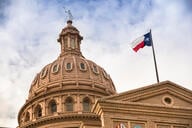You have /5 articles left.
Sign up for a free account or log in.
For nearly a decade, college and university research and business officers have been troubled by a conflict between federal patent and tax laws that restricted the sorts of research that could be done in facilities built (as many are) with tax-exempt bonds. To avoid running afoul of federal tax law because of that conflict, some universities had eschewed tax-exempt bonds when they built research facilities, absorbing millions of dollars in additional costs.
This week, to the satisfaction of campus officials, the Internal Revenue Service appears to have made the problem go away, issuing a ruling that clears the way for nonprofit research institutions to conduct federally sponsored studies in buildings financed with tax-exempt bonds without violating U.S. tax law.
"At first blush, this seems to have been done in a way that will clarify the issue and benefit the university research community," says Tony DeCrappeo, executive director of the Council on Governmental Relations, an association of research universities.
Here's how the conflict arose:
When federal tax laws were rewritten in 1986, Congress excluded the federal government from the definition of a "public entity" for purposes of determining which organizations could take advantage of the tax-exempt bond market to build facilities. (The bond market was seen as a way for state and local governments and nonprofit groups to inexpensively finance such projects; the federal government was seen as having other sources of funds for such projects.) Among other things, the law also mandated that a research organization could not use tax-exempt bonds to finance a facility if more than a small proportion of its research work would be supported through "private" sources.
In 1997, when the Internal Revenue Service issued guidance to govern which sorts of research agreements did and did not amount to unacceptable "private business use" in facilities built with tax-exempt bonds, it set out "safe harbors" that universities and other research organizations could use to guide their decisions. One of the "safe harbors" declared that an agreement with a private entity was acceptable if the research organization did not give the sponsor of the study any right to the results of the research that it did not also extend to any other entity.
That's where the conflict resulted with the 1980 Patent and Trademark Law Amendments Act, commonly known as the Bayh-Dole Act. That law, which was designed to encourage universities to patent and commercialize inventions developed with federal research funds, gives the federal government a royalty-free, nonexclusive license to use any inventions developed using federal funds. That requirement, which ensured the federal government special treatment, appeared to conflict directly with the mandate of the 1997 IRS ruling that all parties maintain equal rights to the fruits of research.
The fact that federally sponsored research would, under the IRS ruling, count as being privately rather than publicly funded made it much more difficult for colleges and universities to ensure lawyers assessing their potential bond issuances that they would fall under the restrictions on the acceptable amount of privately financed research that would be conducted in their facilities. Some universities have put off building new facilities while they awaited a potential change of heart from the IRS.
But in at least a few cases, institutions financed their facilities with taxable rather than tax-exempt bonds, at significantly increased costs. For instance, the University of Iowa built its Carver Biomedical Research Building with $50 million in bonds, about two-thirds of which were taxable, at interest rates up to 2 percentage points higher than the tax-exempt bonds it used. That necessity would cost the institution between $4.5 million to $6 million in present value dollars over the life of the bonds, according to a presentation that its controller, Terry Johnson, gave at the Council on Governmental Relations's annual meeting this month.
The council was among several groups, including the National Association of Bond Lawyers, that pressed IRS to change its guidelines, and it did so this week in a document known as Revenue Procedure 2007-47. The clarification essentially expands the safe harbor to cover federally funded research in which the government receives the rights guaranteed it under Bayh-Dole. In the words of the IRS document itself: "These special rules provide that the rights of the federal government and its agencies mandated by the Bayh-Dole Act will not cause research agreements to fail to meet the requirements of [the tax code], upon satisfaction of the requirements of ... this revenue procedure. Thus, under the stated conditions, such rights themselves will not result in private business use by the federal government or its agencies of property used in research performed under research agreements."
Research and legal experts said they expected that the IRS ruling would reassure college and university officials and encourage greater use of the tax-exempt bond markets to finance research facilities.
"This removes the uncertainty or cloud that's out there," said Scott R. Lilienthal, a lawyer at the Washington firm of Hogan & Hartson.
Johnson, the Iowa controller, said in an interview Wednesday that the IRS guidance would have a significant impact at his institution. The university plans to convert the $33 million in taxable bonds that it issued in 2002 and 2004 to tax-exempt bonds, in a way that will allow it to recoup some of the funds it was projected to spend on higher interest rates.
And, like many institutions, Iowa is "planning more buildings" for research, Johnson said, and "we were really pressing hard to get this clarification, to eliminate the concern about whether we could issue tax-exempt bonds."





